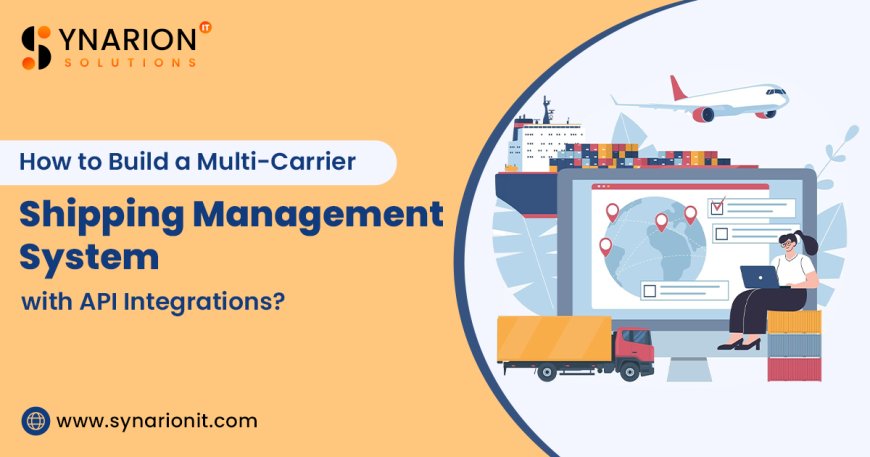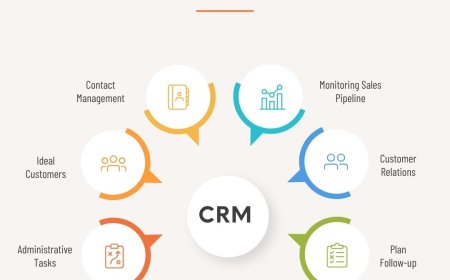How to Build a Multi‑Carrier Shipping Management System with API Integrations?

In todays fast-paced eCommerce and logistics landscape, businesses need efficient, real-time control over their shipping operations. A multi-carrier shipping management system enables companies to automate shipping processes, compare carrier rates, generate labels, and track deliveries from multiple courier servicesall in one centralized platform.
With the growing complexity of order fulfillment, businesses are increasingly turning to custom-built solutions. This is where expert Shipping Management Software Development becomes critical. In this guide, well walk you through the step-by-step process of building a robust multi-carrier shipping management system powered by API integrations.
What is a Multi-Carrier Shipping Management System?
A multi-carrier shipping management system is software that connects your business to multiple shipping carriers (such as FedEx, UPS, DHL, USPS, etc.) via APIs. It allows businesses to:
- Compare shipping rates and delivery times
- Automatically print shipping labels
- Track shipments in real-time
- Manage returns efficiently
- Optimize carrier selection based on cost or delivery speed
Unlike basic shipping platforms, this system offers flexibility and automation, making it ideal for companies with large-scale or complex logistics needs.
Key Stages in Building a Multi-Carrier Shipping Management System
Define Your Goals and Shipping Requirements
Before diving into development, its crucial to define the specific needs your system must meet. Start by answering questions like:
- How many orders do you ship daily?
- What carriers do you want to integrate?
- Do you need international shipping capabilities?
- What types of users will access the system (e.g., warehouse staff, logistics managers)?
- Will the system be integrated with your ERP, WMS, or eCommerce platforms?
Clear answers help you scope the project and guide your Shipping Management Software Development Company in designing a tailored solution.
Choose the Right Technology Stack
Selecting a tech stack depends on your scalability, integration, and real-time data requirements. A typical shipping management system may use:
- Frontend: React.js, Angular, or Vue.js for a responsive UI
- Backend: Node.js, Python (Django/Flask), or Java (Spring Boot)
- Database: PostgreSQL or MongoDB for flexible data management
- Cloud Infrastructure: AWS, Azure, or Google Cloud for scalability and API performance
- DevOps Tools: Docker, Kubernetes, Jenkins for CI/CD pipelines
An experienced Shipping Management Software Development Company can help you choose the most efficient technologies for your budget and performance needs.
Integrate Carrier APIs
Carrier API integration is the core of any shipping management system. Youll need to connect your platform with the APIs provided by major carriers such as:
- FedEx Web Services
- UPS Shipping API
- DHL Express API
- USPS Web Tools
- Canada Post API
- Third-party aggregators like EasyPost, ShipEngine, or Shippo
These APIs allow your system to access services like:
- Rate quoting
- Label generation
- Shipment tracking
- Pickup scheduling
- Address validation
Each carrier has its own API documentation, authentication method, and data format. Your Shipping Management Software Development team will handle API integration layers and normalize the data for seamless user experiences.
Design Key Features and User Interface
The system should offer a simple, intuitive interface for different user roles. Key features include:
1. Multi-Carrier Rate Comparison
Allow users to view and compare real-time shipping rates and estimated delivery times across carriers.
2. Automated Label Generation
Generate and print shipping labels with barcodes based on selected carrier services.
3. Order & Shipment Tracking
Track shipments in real time and update order status across platforms.
4. Bulk Shipping
Support batch processing for label generation, carrier selection, and pickup scheduling.
5. Returns Management
Enable users to create return labels and manage reverse logistics.
6. Dashboard and Reporting
Provide analytics on shipping costs, carrier performance, delivery times, and exceptions.
An expert Shipping Management Software Development Company can help you design a role-based UI/UX system that supports warehouse operators, administrators, and customer service teams efficiently.
Integrate with Existing Systems
To maximize operational efficiency, your shipping software should integrate seamlessly with:
- eCommerce platforms like Shopify, WooCommerce, Magento
- Enterprise Resource Planning (ERP) systems like NetSuite or SAP
- Warehouse Management Systems (WMS) or order management systems (OMS)
This ensures real-time data sync between your inventory, orders, and shipping processes.
Security, Compliance, and Scalability
Since the system handles sensitive data (customer addresses, shipment details, etc.), it's essential to:
- Use HTTPS/SSL encryption
- Implement user authentication and role-based access control
- Ensure GDPR and CCPA compliance if you operate in those regions
- Design for high availability and horizontal scalability
A capable Shipping Management Software Development Company will use industry best practices to protect data and maintain uptime.
Test, Deploy, and Optimize
Before going live, the system must undergo rigorous QA testing, including:
- API testing for reliability and performance
- Load testing to ensure the system handles peak volumes
- User testing to validate workflows and interfaces
Post-launch, continuously monitor system performance and carrier APIs. Use real-time analytics to optimize routes, minimize shipping costs, and improve delivery success rates.
Final Thoughts
In an increasingly competitive logistics environment, building a custom multi-carrier shipping management system can streamline your operations and reduce shipping costs. With robust API integrations, centralized control, and automation, you gain a strategic advantage.
Working with a trusted Shipping Management Software Development Company ensures that your solution is not only functional but also future-proof, scalable, and secure. Whether youre a growing eCommerce brand or a logistics provider, investing in Shipping Management Software Development is a smart move to optimize fulfillment and exceed customer expectations.




































